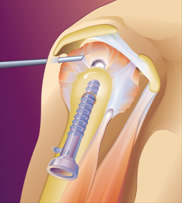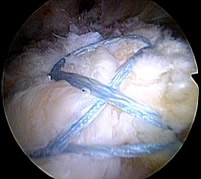Rotator Cuff Repair
The rotator cuff is the thick band of muscles and tendons that covers the top of the upper arm and holds it in place, providing stability, strength and a full range of motion to the shoulder joint. It is made of four muscles and their associated tendons.

These tendons can become partially or completely torn as a result of an acute injury such as a fall or can be degenerative due to wearing away of the tendon slowly over time from repetitive stress or wear from a bone spur.
Rotator cuff tears most often occur as a result of overuse of the muscles over a long period of time. As a result, this condition is most common in patients over the age of 40. Athletes are particularly vulnerable to overuse tears, especially tennis players, golfers and baseball players. It may also occur as a result of a traumatic injury, and involve pain when lifting or lowering the arm, muscle weakness and atrophy.
Partial rotator cuff tears can be treated through nonsurgical methods that focus on relieving pain and restoring function to the shoulder. These may include:
- Rest
- Activity modification
- Anti-inflammatory medication
- Steroid injection
- Physical therapy and strengthening exercises
Surgery is generally recommended for full-thickness tears in active patients that cause persistent pain or that do not respond to more conservative treatments.
Rotator Cuff Repair Procedure

Rotator cuff surgery is performed on a routine basis today as an all-arthroscopic, minimally invasive procedure as an outpatient at the Naples Day Surgery Center. Dr. Guerra has performed over 3000 arthroscopic rotator cuff repairs making him one of the most experienced surgeons in Florida. The procedure is performed under general or regional anesthesia. The goal of the procedure is to reattach the tendon back to the arm, along with smoothing any bone spurs down. Prior to the surgical procedure, our board-certified anesthesiologist will place a numbing agent around the nerves that go to the shoulder under ultrasound guidance. This is called a ‘block’ and lasts up to 24 hours greatly reducing the amount of postoperative pain. Many of our patients will go home with little to no pain.
During arthroscopic rotator cuff repair, several small incisions, about a ¼ inch, are made in the shoulder, into which a thin high-definition video camera about the size of a pen is inserted. The inside of the shoulder is projected onto a high-definition monitor and using tiny specifically designed tools, most of which are manufactured right here in Naples, at Arthrex, the tendon is repaired.

This technique allows for less scarring and shorter recovery times and is the least invasive method to repair a torn rotator cuff.Since Dr. Guerra serves as Medical Director for Arthrex, this gives his patients access to the latest and most current instrumentations and techniques to maximize their results. One of the most exciting areas of research is orthobiologics. These are tissue grafts and injections, like platelet-rich plasma (PRP/ACP), that promote growth of new tissue in the body and may foster healing. Supplementing rotator cuff repairs with PRP makes sense from a theoretical standpoint, but it is so new that there is little scientific data. If you are interested in more information, please inquire at your appointment.
Recovery
The majority of patients report improved shoulder strength and less pain after surgery. Approximately 85 to 95 percent of patients achieve effective pain relief, restoration of function and improved range of motion after their procedure. These results can vary depending on the size of the tear and quality of the tendon tissue as well as the patient's individual condition, age and overall health.
Recovery time depends on the type of surgery. After surgery, the arm will be immobilized for generally 3-4 weeks but can be up to 6 weeks to promote proper healing and avoid re-injury. Physical therapy (PT) starts within a few days of surgery and the therapist will remove the sling and start moving the arm within the safe range of motion. Our patients are assigned to one of three PT protocols depending on the tear size. Most patients attend PT 2-3 times per week for 6 to 8 weeks. By six weeks, patients are encouraged to use the arm for light activities of daily living avoiding any heavy lifting, and by 3-4 months are usually returned to full activity. It is important for patients to commit to their physical therapy program in order to achieve the most effective surgical results.
Risks
As with any surgery, there are certain risks involved with rotator cuff repair such as infection, pain or stiffness, nerve damage or the need for repeated surgery. These complications are rare and most people receive successful outcomes from this procedure. Your doctor will discuss these risks with you, as well as address any concerns you may have, prior to your procedure.
To learn more about rotator cuff repair, and to find out whether or not this procedure is right for you, please call us to schedule an appointment.
